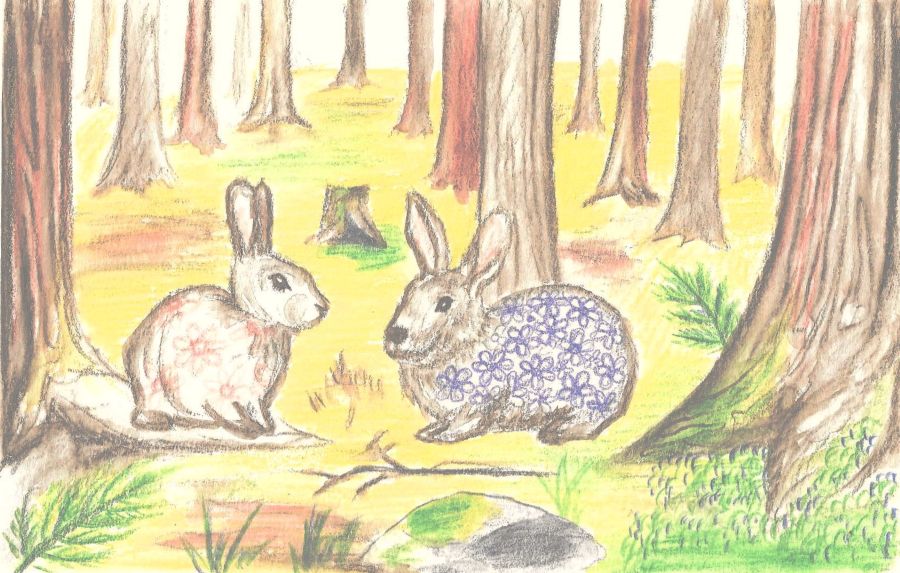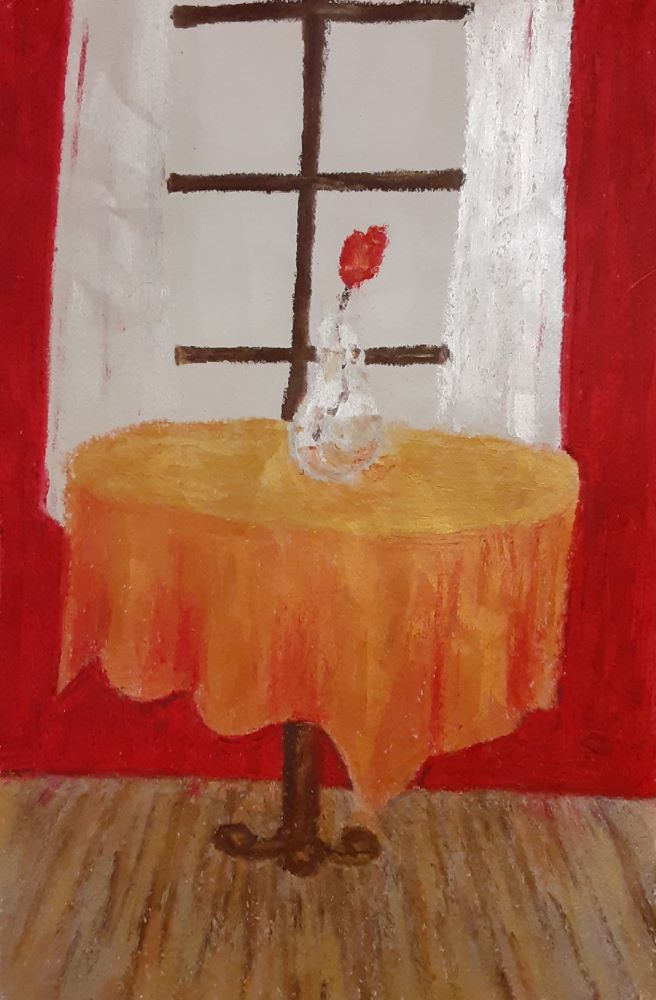Autumn is the perfect time for craft. The desire for coziness is growing, but the outside world is still vibrant and welcoming. Colored leaves call out to be made into a collage, and acorn caps will scold you if you pass them by without scooping them up to use when decorating a forest faerie house. Color becomes precious, and creating beauty becomes more urgent.
There is another type of craftiness, though, that we are pulled towards: not a project to be completed in a single afternoon, but a longer term cultivation of skill and knowledge. As colder weather turns us inwards, we must be more proactive in interacting with the world, with the material around us, peering deeper into its intricacies. Far from the shallow flighty self of summer, the winter self puts down deep roots and thrives on quiet, steady creation.
The novel Knitting by Anne Bartlett explores the activity of craft. Each of the two main characters use it differently in their lives. Sandra is a recently widowed professor who turns to her writing to work past her grief. Martha knits for enjoyment, but beneath the peaceful passtime simmers her intense anxiety about making mistakes. When the two meet while helping a stranger in distress, they form a friendship of opposites. Sandra attempts to overcome her grief by channeling her creative energy into putting on an exhibition about textiles and knitting throughout the last century. She recruits Martha to knit pieces for the exhibition, and so the pressure mounts for Martha to deliver perfect results, and for Sandra to give her life new meaning through this exhibition.
Craft can be closely related to work, as it is for Sandra. It can be associated with healing, as it is for both of them. The products of craft can be utilitarian, as Martha insists: knitting is for keeping people warm. But ultimately craft is a kind of play, a learning and an experiment between a person and the world. The material, whether it is wool, words, clay, or anything else, is becoming something new, and the maker is in a dialogue with it. There is surprise involved, and delight, as the material behaves slightly independently from the maker, defying strict plans. As the maker deepens in knowledge of their craft, this magic only expands–”mastery” over the material only leads to more exquisite surprises. Craft is about accomplishing something, but not by a set of instructions. In its fuller sense, craft is about invention, problem solving, resourcefulness.
As the novel progresses the characters’ worlds become interconnected, and yet also remain very separate. They have fundamentally different ideas about manners and proper modes of behavior. A lot of the tensions and misunderstandings never get resolved, and the characters continue on parallel tracks connected through their respective crafts. Their own creative world is hidden, and each remains the guardian of her long acquired knowledge. They catch glimpses into the joys and trials that the other experiences, but they never really share the extent of their frustrations with each other. Sandra, for all her supposed respect for women’s work and for Martha’s knitting, manages to exalt and then condescend; she gets caught up in the metaphor of craft, the picture of community, losing sight of the reality of it. Sandra is in awe of Martha, but still manages to misunderstand the real creativity and effort involved in what she does.
Martha loves wool. The colors, the textures drive her to creation and experimentation. She makes clothes for herself, gifts for others, and occasionally does sculptural knitting, just for fun. She worked on commission for a high end clothing designer for a period of time, knitting pieces for famous clients, but gave it up because it drained the joy out of the activity, and her work did not feel meaningful. She tells Sandra this early on, but Sandra either forgets or doesn’t quite believe her because later on, Sandra is trying to convince Martha that knitting for the exhibition will be “great publicity,” and that it will help her turn knitting into a lucrative career.
Sandra, for her part, is enchanted by words. She loves finding the perfect ones, seeing the impact they have on an audience, on her students. Her writing work also connects her to the people and subjects that she studies. By trying to put the lives and motivations of others into words, she can participate slightly in their experience. Sandra also clings to the formality of words, and embodies the stereotypical academic who prefers to study rather than participate in creative expression of human feeling. She is very aware of the particular prestige awarded to wordsmiths from which others are excluded, and she claims this as her right. In her time of grief, however, words have become unsatisfying to her.
But the fact was that words had their limitations. There were some things in life, feelings, experiences, for which there were no names. There were no words for the joy she had shared with Jack, and no words for losing him. No words for this mindlessness, this absence.
Sandra is searching for new means of expression and connection. She is captivated by handicraft, and wonders whether practicing it could help her “reconnect with some kind of community, with the long line of women and their work” which she is only connected to through her research. She longs for a more “integrated” life, but she also is in the beginner’s conundrum of laboring over pieces that don’t turn out right, feeling vulnerable from inexperience when she is used to being clear and in command. And while she wants community, the daily effort of creating it with the actual flawed and frustrating women around her weighs against the distant sense of it in her mind.
When Martha first shows Sandra her knitting room, Sandra is blown away by a life-sized horse sculpture that Martha is knitting based solely on horse pictures and anatomical drawings.
She looks skeptically at the reference photos.
“I wouldn’t call those instructions.”
“They’re the best sort. Pictures to follow.”
“But there’s no words, no rules. How can you do it with no words? How do you know how many stitches to cast on?”
“You just try it out. If it doesn’t work, you try a different way.”
Martha works in this way, going along and trying things out, figuring out better or more beautiful ways to knit. We see this process play out in a side project of hers, in a quiet moment.
“Only a few minutes before, she had decided to change the pattern for the skirt of this new dress. … For weeks she had searched and thought, feeling her way toward the form, and now the sense of the whole had crept quietly into her mind when she was least expecting it. Martha’s heart leapt with recognition.”
This is the real joy for Martha, to mull over problems, to have ideas arise and to fall in love with them. The real creativity of her craft cannot be planned out. It happens as a surprise, a gift.
Martha’s abilities convince Sandra that she is perfect to do the knitting for the exhibition. However, Martha is hesitant, knowing that she cannot sustain large projects which she doesn’t have control over. Sandra has her mind set on the exhibition idea, and pushes Martha to agree to participate.
“I’m just a home knitter, that’s all.”
“No you’re not, Martha. You’re brilliant. You must know that. And this will be simple stuff for you. You’re capable of work way beyond this. You’re a real artist, the way you challenge ideas, experiment with fiber and color. Look at those wall hangings or that horse sculpture–that’s not home knitting, that’s art.”
“It is home knitting,” Martha said stubbornly. “I do it at home. I do it for fun, for people I care about. I’m just mucking about, that’s all, having fun. You make it sound important, like a kind of work. Well, it is work, but it’s happy work, work that I like, that I do when I’m in the mood. But if I have to do it, I might not like it anymore. I won’t be able to choose it. I don’t like deadlines. I crack up when I get too busy, with too much stuff in my head. My work needs to be playing.”
Ultimately Martha does agree to knit the pieces for Sandra, because she doesn’t want to disappoint her. In her own world again, Sandra quickly loses sight of the process of Martha’s creative work, and instead thinks only of timelines, efficient production, and the crippling fear of a failed exhibition. Soon she is reducing Martha’s role entirely. She thinks to herself,
“Martha was lucky. All Martha had to do was read the pattern and follow it. Pure mechanics. Whereas she, Sandra, had to think and decide and be responsible.” Sandra can feel the difficulty of her own effort, and does not find her mirror image in Martha.
When Martha cannot meet the ambitious deadlines, Sandra tries to exert more control over the project, highlighting to Martha how distant Sandra really is from the craft she claims to value.
“Look, how about this?” Sandra had ruled up a progress grid for each of the garments. “See, you can do them one at a time, or several at once if you want variety. Then you won’t get bored.”
Martha could see that Sandra didn’t have any idea. She hadn’t allowed for sewing up, or for the embroidery on the bed jacket. She had assumed that the baby’s jacket would take half as long as the adult sweater, simply because it was smaller, not realizing that because it was finer and in five pieces, it would take at least the same amount of time.
The two women never actually talk this out, and Sandra does not learn the deep secrets of knitting. In the end, when Martha gives Sandra a gift that she has been secretly knitting for her throughout most of the novel, its significance doesn’t rest in Sandra’s new enlightened understanding of the craft. It does matter, of course, that it is handmade, that Martha created it for her specifically, and it is a symbol of their friendship. But ultimately the crafted object breaks away from the process of its making to become its final form. It is not even the beauty of the dress, but the physical experience of wearing it that has healing power for Sandra.
Craft can connect people with the world and enrich their personal experience, but how can it connect people with each other? If people are creating together, learning from one another, or sharing the products of their labor, a sense of fellowship and community can be felt. But in another way, one’s craft always remains personal. It is an internal knowledge, a wordless connection to the material and activity.


